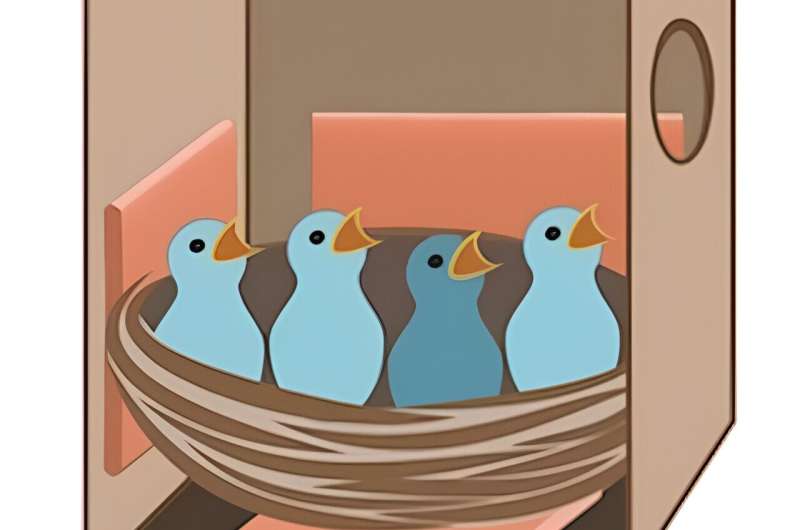This article has been reviewed according to Science X's editorial process and policies. Editors have highlighted the following attributes while ensuring the content's credibility:
fact-checked
peer-reviewed publication
trusted source
proofread
Researchers find unusual heat resilience in tree swallows

Tree swallows use behavioral and physiological mechanisms to handle rising temperatures, and their story is an optimistic example of how some species successfully respond to climate change, at least for now.
It's a difficult time to study birds. Their numbers are down, their habitat is changing, and their prey are disappearing as heat waves grow more common and more intense. Yet, Kim Rosvall and Mary Woodruff of the Department of Biology within the College of Arts and Sciences at Indiana University Bloomington have identified a bird that seems to be handling some of these challenges surprisingly well. Their multi-year studies of the tree swallow demonstrate that these birds can employ behavioral and physiological mechanisms to handle the heat.
A research question is born
Step into Associate Professor Kim Rosvall's office and there's no mistaking what she studies. Pictures, paintings, and even knit figures of tree swallows fill every wall and shelf. Rosvall has studied the iridescent blue-green and white birds for 20 years, focusing mostly on aggression.
But recently, scientists noticed something strange about the tree swallow.
The tree swallow is moving south, expanding its breeding range in the hot and humid Southeastern US, while most other North American bird species are shifting north or up a mountain, into cooler temperatures.
Rosvall emailed this curiosity to then-prospective graduate student Mary Woodruff, who was immediately hooked. "As soon as we were in person and sat down, we did the pleasantries and [Rosvall] asked, 'what do you want to talk about?'" recalled Woodruff, "and I said, 'I want to talk about the tree swallows moving South.'"
What followed was a 45-minute conversation brimming with questions and reflection. "It really felt like an exciting science conversation," said Woodruff. "Why, amidst climate change, would a wild animal be shifting its range into a warmer environment? That's totally counterintuitive."
"I love thinking about the birth of our work on heat because it was very organic and student-led," said Rosvall. "One of the things that we pride ourselves on [in the department] is to let students follow their heart and their curiosity."
A few months later, Woodruff joined the lab as a graduate student and began to study tree swallow tissue samples from across the United States. In particular, she examined levels of heat shock proteins (HSP): a class of molecules involved in repairing damaged proteins.
She found that birds breeding in warmer regions had higher HSP levels than their northern neighbors and wondered whether these molecules helped the birds handle higher temperatures.
She published her results in Science of the Total Environment in 2023.
"At first, we thought 'oh wow, they're totally heat adapted! Even these young chicks can handle some heat with behavioral adjustment' but then we said 'wait, what if it just wasn't hot enough?'" said Rosvall. "I didn't want to give up on what had felt like a good question," added Woodruff. So, they checked the safety and then raised the temperature 1.7ºC higher in a second study (currently on the bioRxiv preprint server), still far below the lethal limit of the tree swallows.
When birds were exposed to this temperature for four hours, the researchers found both behavioral and physiological changes. The tree swallows panted, spread out, and activated several physiological responses including HSPs, antioxidants, and anti-inflammation responses. "In a sense, behavior was not enough," added Rosvall. "They needed that physiological change to cope with heat."
Interestingly, the researchers also found a lasting, positive effect of the short heat challenge. "Birds exposed to a little bit of heat were more likely to survive to breeding age," explained Rosvall.
"Stress can expose new variation upon which selection can act." As temperatures continue to rise, the tree swallows with higher HSP levels may fare better and pass on their genes to the next generation, gradually increasing heat tolerance over time.
To other birds and beyond
Woodruff wrapped up her work on tree swallows in December of 2023, when she successfully defended her thesis and received her doctorate in Evolution, Ecology, and Behavior. Still, she continues to reflect on her heat experiments and encourage others to explore similar topics.
"I was surprised that the story was so hopeful, but I'm thrilled that it is," said Woodruff. "But what about a species that doesn't seem to be doing that well in the face of climate change? Or what about when it warms even further?"
Rosvall agreed, wondering. "If a little bit of heat is good for an animal, is there something we can do to help animals thrive in our warming world?"
It's a big question, and one that will require much more research to answer. If animals could be 'primed' through brief, artificial heat exposure to make the behavioral and physiological changes that tree swallows do, they may be better able to cope with rising temperatures due to climate change.
Experimental research on how wild birds handle heat is still in its infancy, but the Rosvall lab and its trainees will continue to propel the field forward and ask these unconventional questions, always with the tree swallow as their guide.
More information: Mary J. Woodruff et al, Organismal effects of heat in a fixed ecological niche: Implications on the role of behavioral buffering in our changing world, Science of The Total Environment (2023). DOI: 10.1016/j.scitotenv.2023.164809
Mary J. Woodruff et al, How altricial birds respond to a heat challenge: organismal perspectives on coping with a future climate scenario, bioRxiv (2024). DOI: 10.1101/2024.01.11.575240
Journal information: Science of the Total Environment , bioRxiv
Provided by Indiana University



















